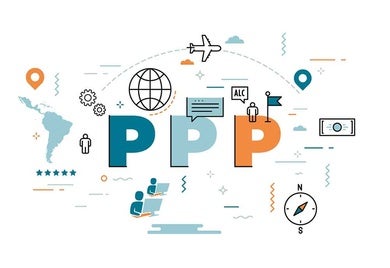Blogs Navigation
Sustainable BusinessRecent posts

Latin America and the Caribbean at the forefront of energy and technological progress
The region is rich in essential minerals and has the potential to develop its value chains. Countries must overcome several challenges to take advantage of these resources and their benefits. This requires transparency, governance, and attracting private investment.

We Helped a Solar Plant Hire More Women. Will the Industry Follow Suit?
The Lucayas Solar Power Project in the Bahamas marked a milestone by pioneering the integration of women in the construction of solar photovoltaic plants. What we learned in the process can help other companies’ commitment to gender equity.

Overcoming Three Challenges to Unlock the Potential of Green Hydrogen
Several countries in Latin America and the Caribbean have an adequate renewable energy generation capacity, abundant water resources and other favorable conditions to diversify the power generation matrices and decarbonize energy-intensive industrial segments. Breaking down legal, regulatory, financial, technical and market barriers can help them lead the charge on clean energy initiatives.

What have we learned after a decade of public-private partnerships in Latin America and the Caribbean?
Until the end of 1990, Latin America and the Caribbean was the region with the greatest proliferation of public-private partnerships (PPPs). At that point, investments plummeted, partly due to negative reactions caused by its deficient implementation. In 2005, thanks to the joint efforts of public, private sector, and multilaterals, PPPs became again a widely used tool. Driven by the fall in commodities prices, the increase of fiscal deficits, and the improved conditions for implementing PPPs, many countries established specific institutions and strengthened their regulations. As a result, investments through PPPs grew almost five times, from US$8 billion in 2005 to US$39 billion in 2015. In barely one decade, Latin America and the Caribbean has registered US$361.3 billion in investments for almost 1,000 infrastructure projects through PPPs, primarily in the energy and transport sectors. PPPs potentially can help to overcome some of the public-sector limitations but they also raise concerns. Large-scale projects involve many technical, financial, environmental, and social risks. PPPs demand greater attention to risks assignment, conflict resolution, and the analysis of “value for money.” They also require institutional development that takes time to consolidate and, when it is poorly done, can even increase costs and reduce services or its quality. Transparency is also key to mitigate the risk of corruption, which has become more visible in Latin America and the Caribbean in recent years. In this context, multilateral development banks can play a key role supporting the development of proper environments for attracting private investment, supporting independent projects preparation, and helping to bridge financing gaps. These banks, also have a potential comparative advantage: their ability to be directly involved with the public and private sectors. 10 keys for strengthening the multilaterals’ support for PPPs The Office of Evaluation and Oversight has reviewed IDB Group support for PPPs in infrastructure projects at three levels: favorable environment, project preparation and financing, besides other development banks’ experience. These banks financed a small (3%) but considerable proportion of PPP’s investment in Latin America and the Caribbean. The IDB Group provided the most financing (35%), among these entities, with 145 approved operations for US$5.8 billion between 2006 and 2015. Based on our conclusions, the Evaluation of Public-Private Partnerships in Infrastructure, published last March presents 10 recommendations: Specific diagnostics: identify and evaluate potential demand for PPPs by country, including analysis of infrastructure needs in the sector, PPPs environment, fiscal limitations and risks, and type of support needed by the governments. Priorities: include a general framework to determine which countries and sectors need support, type of support needed, and define priorities. Focal point: establish a PPP focal point with sufficient authority and resources to promote collaboration among all parties involved in the institution. Capacities: do an inventory of existing capabilities, identify what is missing, and try to attract and maintain the necessary capabilities. Incentives: reform the incentives, granting rewards when private investors’ funds are mobilized and creating incentives for collaboration. Advisory services: Analyze infrastructure projects in the pipeline, and advise countries regarding the most suitable delivery model, regardless of the sector that will originate the operation. New products: Explore the use and development of new financial and advisory products tailored to the countries’ specific needs, such as local currency financing, advisory services, specific instruments supporting subnational governments, and project preparation mechanisms. Results framework: examine the value for money of PPPs operations, the quantity and quality of the services provided, costs to the taxpayer and the user and its sustainability, in addition to evaluating whether critical environmental and social objectives have been met. Knowledge: Design a specific knowledge strategy on PPPs to systematically capture and file the results of operations and lessons learned. Lessons learned:Systematically incorporate lessons learned by your own organization and other banks on the design and implementation of new PPP operations. Many Latin American and Caribbean countries with solid capacity for implementing PPPs have an extensive list of potential projects, and practically all the larger countries have an infrastructure investment program in which PPPs play a fundamental role. Moreover, since in some of the region’s most important economies the ratio between private investment and gross domestic product (GDP) continues to be low, there is a considerable margin for new projects. The development banks are well positioned to play a fundamental role in these future PPPs, providing support to ensure their suitability in economic, environmental, and social terms, to generate favorable environments that attract private investments, and to close the financing gaps. Only if these recommendations are implemented will we be able to contribute to a wave of successful PPPs and avoid the negative reactions we have seen in the past. The IDB Group has accepted the recommendations and is ready to put them into practice. Subscribe to receive more content like this! [mc4wp_form]

Mining Bitcoin in Latin America: opportunities … and dangers!
The discovery of the first gold nuggets in General Sutter’s sawmill became a true “gold rush” in the United States. In the mid-19th century, California attracted a generation of immigrants and adventurers looking to become wealthy in the blink of an eye, with their picks and shovels. However, to achieve this dream it was necessary capital, energy and luck. In addition, this adventure involved greater economic and physical risks. According to my family story, my great-granduncle was among those enticed by the gold fever, leaving Ireland behind with its poor potato harvests and economic policies dictated from London. Like most of immigrants, his dreams of a golden wealth soon were vanished. Nonetheless, over the following decades, California would become a vibrant state where film industry, commerce, aeronautics, and more recently, technology, would thrive. The “gold rush” and the determination of those pioneers were the initial catalysts for California’s vibrant economy that today continues to spread wealth and benefits on a global scale. Mining Bitcoin Today we live in a world where the real and the virtual are merging. In a world where data is considered the new oil it is not surprising that the mining trend is data mining, more specifically, Bitcoin mining. But, what is Bitcoin mining? Bitcoin is a cryptocurrency based on Blockchain technology. This technology is nothing more than a long chain of records; a digital, decentralized, immutable, sequential, and encrypted “ledger.” The chain is not controlled by any central authority but by an enormous computers’ network in charge to verify that the information saved in the component blocks is consistent. The key for the security of the chain of blocks is a hash, a cryptographic mathematical bit that makes the links among the blocks practically unbreakable. Returning to Bitcoin, the cryptocurrency originated from a “mining” process in which “miners” compete to solve complex mathematical problems using computers that run algorithms. Every ten minutes, whoever solves the problem and validates the chain with at least 51% confirmed by the miners is the winning miner. The new chain is then encrypted with a new block and copied in all the computers in the network. Obviously, the reward for the winning miner is paid in Bitcoin. Not a bad deal, considering that the value of a Bitcoin has increased from $700 to $16,789 in the last year alone (value at December 14th, 2017). What do we need to mine Bitcoin? Like gold miners a century and a half ago, a digital miner requires some capital, an Antminer S9, “plug and play” hardware; enough energy to run the computers day and night; and a great deal of luck to figure the solution based on computational capacity only. These days, the competition for Bitcoin mining is brutal and inefficient without economies of scale. Besides, like gold nuggets in California that became increasingly scarce, the total number of Bitcoins to be mined is fixed. American curiosities Unlike the “gold rush,” to mine Bitcoin there is no need to go to Silicon Valley. Digital technologies are geographically agnostic, which is beneficial for those who are most desperate to find solutions to their pressing issues. In Venezuela, the case of Bitcoin mining is emblematic and there are those who believe it could be the first country in the world to adopt Bitcoin as currency. The country suffers from high inflation and a weakened currency. But if you add the fact that energy is practically free in Venezuela, the country has some of the ingredients to become a paradise for miners. However, the indiscriminate use of energy has already caused significant tensions between the miners and the authorities. In addition, in the United States, the Bitcoin entrepreneur, Charlie Shrem, was arrested, accused of conspiracy for facilitating the use of cryptocurrency on the Silk Road platform. On one hand, it is evident that there is demand for a digital, credible unit of value free of interference from the central authorities. On the other hand, this logically creates tension with the traditional players (i.e. governments, central banks) and the desire to define basic game rules, in a context where reality advances at a faster than the ability to regulate it. Meanwhile, the Bitcoin fever continues, and the Blockchain ecosystem is still on the front pages. The Latin American company, Ripio, with its business model of person-to-person loans, has raised $37 million selling tokens through an ICO (“Initial Coin Offering”)! The “gold rush” drew adventurous immigrants to California’s mountains. As happened with the Irish, they were driven out by bad administrations and various misfortunes, and were willing to risk it all. As a result, California’s economy is one of the most dynamic in the world. Today, the Bitcoin fever is attracting another type of miner, a digital miner. Some will be successful and make their fortune from the valued currency. In certain countries, some of them will be imprisoned, accused of wasting electricity. But for many, cryptocurrency mining is seen as one of the gears of a new technology that over the long term may become an alternative to certain fiduciary currencies, making the digital economy even more efficient. Mind you, miners and investors, proceed with caution! Subscribe to receive more content like this! [mc4wp_form]

Can your company be a sustainability champion?
Long-term financial performance is directly proportional to good governance, environmental stewardship and social responsibility, but you probably already knew that. If so, then you should also be able to prove it and measure it, because nowadays a vision is not enough to convince your clients. “What gets measured gets managed.”- Peter Drucker (known as the father of modern management) The Problem What if I tell you that purpose is not enough and that measurement encourages ambition? When I look back to my early school days I remember some of the —silly, but edifying— competitions with my friends and classmates. The range of our “high-performance rivalries” went from copying text from the chalkboard into our notebooks in the fastest possible time, comparing math grades at semester end, scoring backheel goals in a soccer match and much more. Measuring and comparing records was the motivation for continuous improvement to beat my own achievements and those of my fellow mates. But what does that have to do with sustainability? Everything. Measuring progress using a comprehensive yet meaningful list of indicators is the core foundation to turn sustainability into a competitive advantage. The Solution: Measuring, reporting, disclosing. Year after year more corporations perceive the competitive edge existent in being part of a sustainability rating and index. According to the Governance & Accountability Institute, 82% of S&P 500 Companies published Corporate Sustainability reports in 2016. In this context a sustainability index is a barometer to measure the success level of a company. It acts not only as an MRI to detect environmental, social and governance issues, but also indicates the economic relevance of sustainability parameters for corporate management and investors. But we need to go further. A recent report from KPMG on corporate responsibility and sustainability indicates that simply linking corporate responsibility activities thematically to the United Nations Sustainable Development Goals (SDGs) is not enough. People want to know how companies are contributing to achieve the goals, and what is the actual impact. Not only does civil society want this information, but also several large institutional investors are exploring how to align their investment approaches with the SDGs. This is why full transparency and full disclosure are key. The economic relevance of sustainability parameters for corporate management and investors are manifold. A study by the University of Oxford showed impressive results on how disclosing sustainability practices can drive financial outperformance. For example, 90% of the studies on the cost of capital indicate that sound environmental, social and governance (ESG) standards lower the cost of capital of companies. If only there were a specific tool for companies in Latin American and the Caribbean to measure and compare performance of environmental, social and governance (ESG) indicators…THERE IS. IndexAmericas IndexAmericas is the world’s first sustainability index exclusive to Latin America and the Caribbean region. Created by the IDB Group (Inter-American Development Bank and IDB Invest) in partnership with Thomson Reuters, S-Network Indexes and Florida International University, IndexAmericas recognizes the top 100 publicly traded companies operating in the region and leading the way in sustainability. It also identifies the top 30 sustainable companies headquartered in the region. IndexAmericas focuses on four key dimensions: environment, society, corporate governance and development (ESGD). Different from other sustainability indexes, IndexAmericas assesses publicly data rather than using a self-assessment questionnaire. It is a management tool that measures more than 400 ESG indicators and 15 IDB Group proprietary key development indicators to evaluate corporate sustainability. I think professor Peter Drucker would be proud to see this achievement. Want to learn more? Visit IndexAmericas [gallery type="slideshow" size="full" link="none" ids="8440,8441,8443,8442"] Subscribe to receive more content like this! [mc4wp_form]

Financing value chains: A need for speed
The technological revolution has come to stay in finance, bringing with it a transformation in how small and medium enterprises (SMEs) in value chains obtain financing and streamlining relations between anchor companies and their suppliers, customers, and collaborators. How does it work? Imagine a company that manufactures aluminum auto parts in Mexico, the principal anchor between the metal supplier and the customer who buys the finished product. The supplier requests the payment as soon as possible, within 30 days, due to its limited working capital. However, 270 days elapse from the time when the company receives the supplies and produces the parts until the sale of the final product. Clearly the money cycle does not match, and the company must pay for its purchases before producing the parts, making the sale and even charging the customer. Existing market conditions make the situation even more difficult, and the increase in aluminum prices does not allow price adjustments from the company to the customers at the same pace that price metal fluctuates. This means that costs for the company increases more rapidly than the final price of its products. Not only Mexico’s automotive industry suffers from the complexities of the cash flow ratio (between the average period to pay the supplier, process the supplies, and collect from the customer), it is even worse in other industries, such as supermarkets. Moreover, the World Trade Organization says that half of all SME requests for financing are rejected, compared to only 7% of the requests made by multinational companies. Access to appropriate and timely financial services for all actors in the value chain is key to achieving successful results. Not only large companies, large producers and traders need access to appropriate financial services suited to their money cycles; small producers need them even more for their survival and financial balance. Thus, value chain financing seeks to fill the gaps created in the anchor company-supplier relationship, as well as to mitigate the perceived risks through innovative ways of providing financial services. But what is the relationship with technology? Value chain financing requires trusting and durable relationships among the different actors and financial institutions. Each party involved must know and understand the other. Access to innovative and flexible financial products and services is vital. Financial technology (fintech) companies help to make this happen and ensure that financing is flexible, transparent, reliable, and accessible 24/7. Fintech companies are a bridge between the anchor company’s requirements and its suppliers and collaborators, through technologies applied to banks’ middle and back offices. By using internet platforms, fintech allow millions of SMEs to access loans, under conditions equal to those enjoyed by larger and more established companies, the missing piece in the puzzle without any doubt. Most financial innovation companies in Latin America and the Caribbean have arisen in the region’s largest markets, including Brazil, Mexico, Colombia, Argentina and Chile. Alliances between fintech companies and financial institutions have been key to bringing promising solutions to scale. But it is not simple. IDB Invest is an essential part of the value chain financing circuit in the region, through strategic alliances with its clients (the region’s large anchor companies) and fintech firms. These alliances allow IDB Invest to support the base of the pyramid in Latin America efficiently. The first step was taken in Mexico, where a framework contract was signed with the fintech eFactor, a Mexican company that offers electronic factoring services for the discount of credit rights derived from the demand for goods and services by large buyers. This marks an important milestone for IDB Invest in its value chain financing transactions and in the creation of scalable and efficient solutions. You can also see more on the impact of the fintech revolution in Latin America and the Caribbean in this full report. Subscribe to receive more content like this! [mc4wp_form]

Tourism development through PPPs: An opportunity to generate employment in Latin America and the Caribbean?
Tourism is one of the world’s largest industries, particularly in terms of employment. This industry generates one out of every 11 jobs in the world, represents 10% of gross domestic product (GDP) worldwide, and 7% of exports, according to the World Tourism Organization. International arrivals around the world grew from 25 million in 1950 to more than one billion in the last few years, a period during which arrivals in developing countries exceeded those in developed countries. But what are the characteristics of employment in this industry? Why are coordinated public-private investments needed? How can we measure the impact of an investment in tourism on employment? Does investment in tourism always have positive effects on employment? Tourism and employment One of the main reasons why the developing countries are so interested in the tourism industry is its job creation potential. Expansion of the tourism industry generates direct, indirect, and induced jobs. Besides, it is a diverse and labor-intensive sector, and thus an effective generator of a wide range of job opportunities. Tourism employs more women, young people, and people with limited education than most industries, promoting an environment of inclusion and empowerment for vulnerable groups. In addition, given its low barriers to entry, this industry provides investment opportunities for entrepreneurs to start small-scale businesses and hire workers. The need for coordinated public-private investments The economic benefits of tourism do not usually reach their optimum (social) level with isolated private sector investments alone. The geographic concentration — dependence on natural and/or cultural attractions — and goods and services complementarities characteristic of this industry highlight the importance of factors like economic agglomeration effects, spillover effects, and externalities. In this context, investment decisions are interrelated so the potential benefit of a specific investment depends on the complementarity of other investments. Thus, without adequate coordination among investors, the market fails to allocate resources optimally. For example, hotel owners may under-invest in hotel capacity as their returns depend on the investment decisions made by restaurant owners and other investors in recreational and cultural activities. Similarly, public investment in infrastructure for transportation and tourism — such as roads, lighting, restoration of the historical and cultural heritage, among other investments — is limited by lack of coordination with the private sector, to generate an adequate flow of tourists. A recent experience in Latin America and the Caribbean Between 2003 and 2010, the government of the province of Salta implemented a series of interventions to generate a structural change in the tourism industry and create jobs after Argentina’s economic crisis in 2001. These investments required a high degree of coordination and collaborative frameworks to foster public-private partnerships (PPPs). The initiative was also supported by a loan from the Inter-American Development Bank (IDB) Group. The Tourism Development Policy (PDT, by its Spanish acronym) was based on three pillars: i) construction and modernization of the transportation and tourism infrastructure; ii) tax incentives for the construction, expansion, and remodeling of hotels and other types of lodging; and iii) institutional strengthening of tourism entities and a comprehensive and sustained national and international advertising campaign. How do we evaluate tourism’s impact on employment and what are our findings? In a recent study conducted by the IDB Group, we evaluated the impact of the PDT on employment using a methodology known as the Synthetic Control Method. Specifically, we used a weighted combination of other Argentine provinces to construct a ‘synthetic leap’ that reproduces what would have happened with employment in the absence of the policy. What were our main findings? The PDT created 1,376 new jobs in the tourism value chain of Salta province between 2003 and 2013. Fifty percent of this growth was led by the hotels and lodging sector. The PDT did not displace employment in other industries. On the contrary, it produced spillover effects and positive externalities in employment. For every job created in the tourism value chain, a new job was created in the rest of the economy. This means a total of 3,750 new jobs in Salta’s economy. So, does every investment in tourism have a strong positive impact on tourism? Not necessarily. Although an increase in tourism services supply and demand may benefit other industries, both through direct and indirect spending and multiplier effects, it may also produce displacement (crowding-out) effects. These latter are negative effects that may occur in other sectors, due to restrictions on the supply of labor, capital, or land. The effect in employment may be negative if the increased demand in labor generates higher salaries and captures employees from other sectors; this means, if employment in tourism grows at the expense of a reduced employment in other industries. This did not happen in the case of Salta, due to regulation of the minimum salary in all industries, and the high level of unemployment, characteristic of the province during that period. Similarly, no negative effects were anticipated due to pressure on other supplies prices (cost of capital and land) or reduced competitiveness in export or import markets through appreciation in the exchange rate. This was possible in the case of Salta given its industries’ low capital intensity, significant amounts of available land, and limited influence on the exchange rate, added to the devaluation context affecting Argentina at the time. Due to Salta’s characteristics and specific context, and the comprehensive public-private approach of the PDT, the positive multiplier effects of investments in tourism offset the negative effects; moreover, resulted a significant increase in total employment, above and beyond the tourism industry itself. Subscribe to receive more content like this! [mc4wp_form]

New ways to increase infrastructure investment
Historically, Latin America has invested 2% to 3% of regional gross domestic product (GDP) per year in infrastructure, even though it should reach at least 5% to meet the region’s needs. This difference creates a gap so large that can only be reduced with both private and public investments participation. What progress has been made to close this gap? Colombia and Chile are the countries with the highest capacity to carry out sustainable Public Private Partnerships (PPPs) in infrastructure in the region, according to the Infrascope. Chile has a long tradition of private participation in infrastructure projects that goes back 25 years. Also, it has a sound regulatory framework supporting PPPs, a solid investment and business climate, and has developed financing instruments. Colombia also enjoys a strong regulatory framework, supported particularly by the 2012 PPP law, and the strength of the institutions in charge of developing and maintaining PPP contracts. In the past five years, Chile and Colombia have awarded 70 and 30 PPP projects, respectively. What can we learn from these countries’ experiences? Colombia and Chile are two examples for the rest of region, especially regarding its regulations and PPPs' maturity, where both countries scored first in the ranking for these two Infrascope’s assessment categories. Colombia, for example, has incorporated the lessons learned from preceding toll road concession programs in the current 4G framework, particularly in the areas of: 1) risk allocation; 2) contracts financial structuring; 3) standardization of technical studies, financial models and methodologies to value risk; 4) streamlining and standardization of contracts; and 5) improvement of bankability, through the inclusion of lenders’ step-in rights and dispute resolution provisions; among others, according to a recent report from the Inter-American Development Bank (IDB). [clickToTweet tweet="Latin America needs to invest 5% of its GDP in infrastructure per year" quote="Latin America needs to invest 5% of its gross domestic product (GDP) in infrastructure per year" theme="style1"] However, while the progress is important, there are challenges that remain, particularly, in mobilizing financing for the already awarded projects. Until now only eight projects have achieved financial closings for approximately $4 billion and there are still $10 billion remaining to finance. The lessons and challenges from the 4G road concession program in Colombia are not unique to this sector, other infrastructure areas face similar constraints when it comes to accessing financing. It is no coincidence that the Infrascope’s Financing category yields the lowest score of the five assessment criteria for the 23 countries analyzed, with an average of 45 over 100. Moreover, when it comes to developing innovative financing solutions, such as mobilizing institutional investors to close the infrastructure investment gap, even countries like Chile, still faces some challenges. In this country, the local regulations do not allow private pension funds to directly finance infrastructure projects. How to help the region bridge the infrastructure financing gap? To bridge this gap there are common features in place that are working. For example, countries like Brazil, Chile and Peru, that are ranked the highest in the Infrascope’s financing category, share the common feature of having some of the most developed capital markets in the region, with freely traded local-currency bonds from public and private issuers, as well as low sovereign risk. Another example is Colombia and its work to address this gap through institutions like the Financiera de Desarrollo Nacional (FDN). This entity develops innovative financial products to reduce the financing costs for the projects and to facilitate access to finance and to capital markets, through credit guarantees and senior and subordinated debt with long tenors. Recently, the FDN launched a new product consisting of local currency loans to attract international investors that can provide guarantees and take the credit risk in the exposures but prefer to avoid the exchange rate risk. [clickToTweet tweet="Issuing impact development bonds and green bonds is key to increase infrastructure investments" quote="Issuing impact development bonds and green bonds is key to increase infrastructure investments" theme="style1"] The lessons learned so far highlight areas that need to advance such as: 1) opening up the markets to local institutional lenders (i.e. private pension funds and insurance companies); 2) issuing impact development bonds and green bonds; 3) promoting access to project development funds; and 4) facilitating innovation with more sophisticated products in the financial sector and capital markets. The debentures guarantee of Santa Vittoria do Palmar in Brazil and the B-bond for Campo Palomas in Uruguay, both structured by IDB Invest (formerly known as Inter-American Investment Corporation) show that the role of the private sector arms of multilateral development banks continues to be very relevant. These projects underscore the value of delivering innovative financing solutions and partnering with key public and private stakeholders to close the infrastructure financing gap in the region. Subscribe to receive more content like this! [mc4wp_form]


